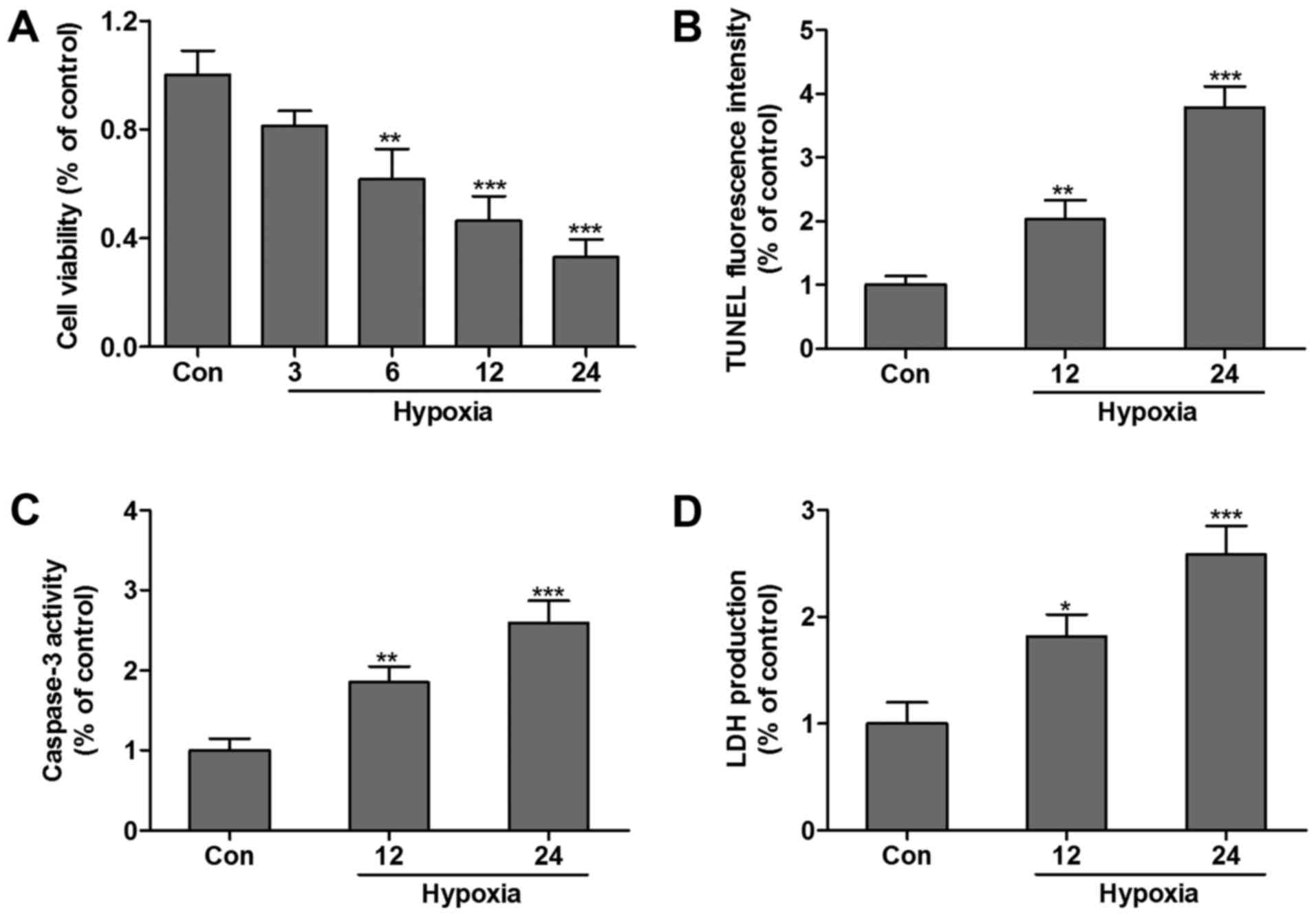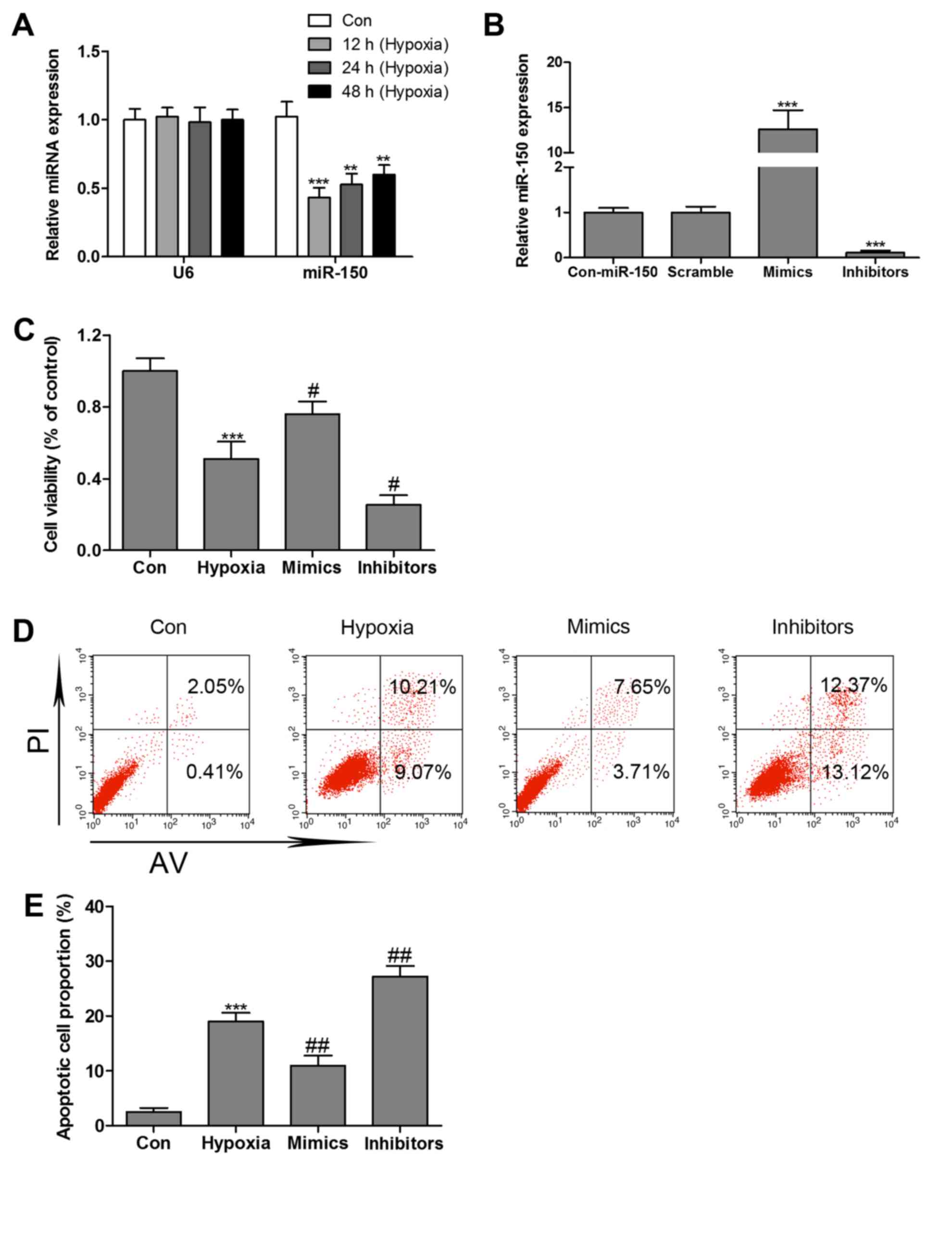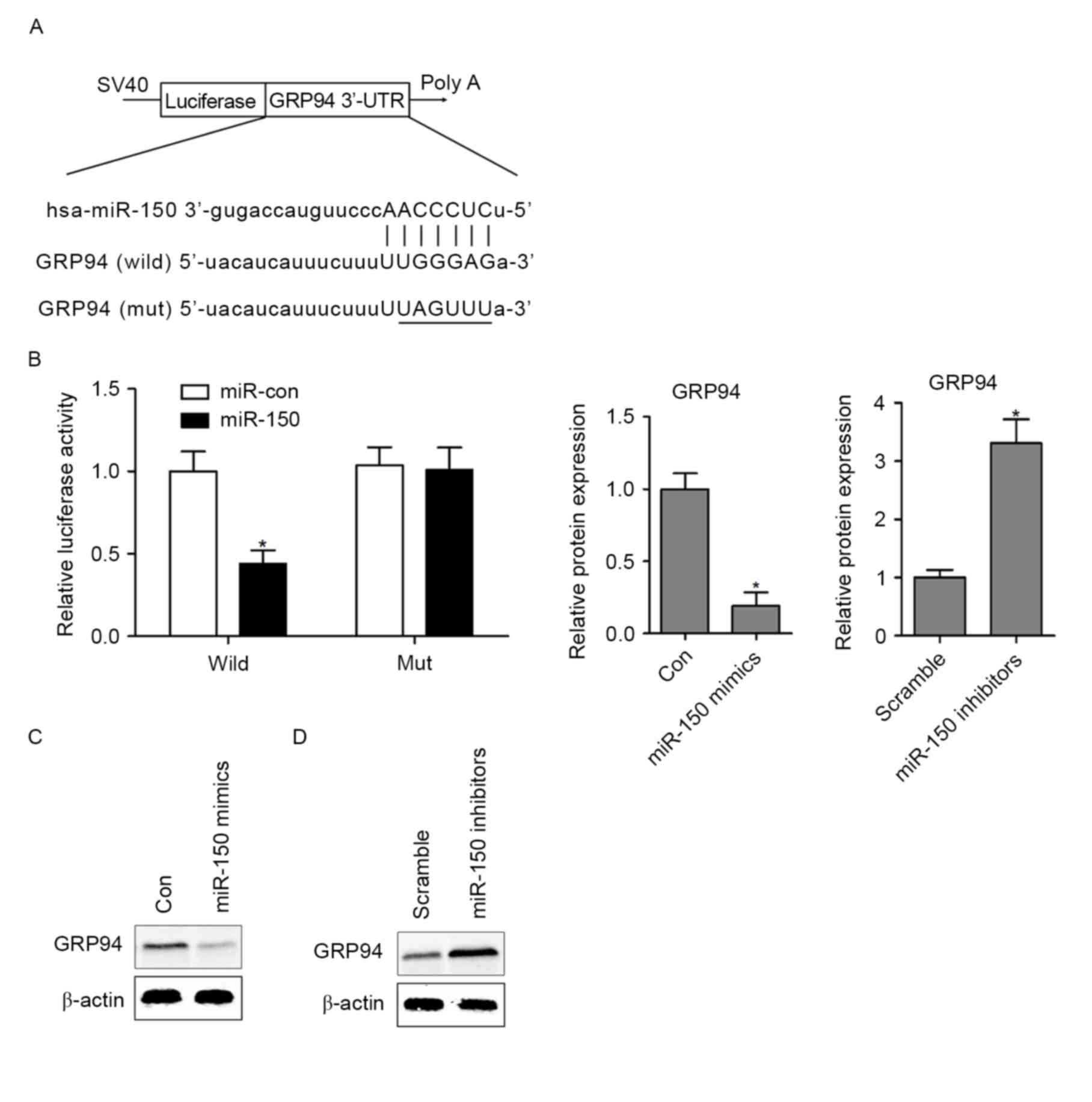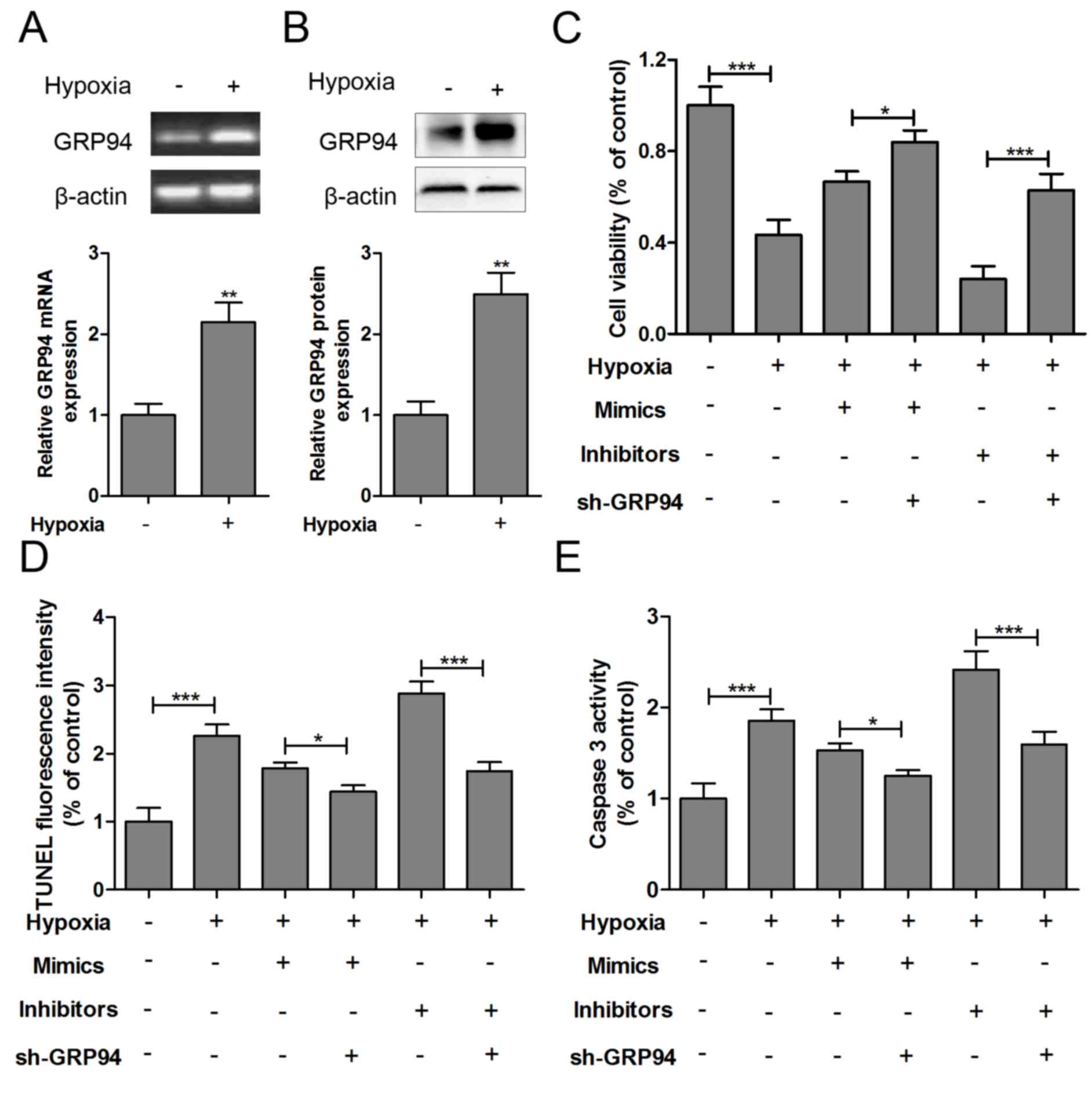|
1
|
Loor G and Schumacker PT: Role of
hypoxia-inducible factor in cell survival during myocardial
ischemia-reperfusion. Cell Death Differ. 15:686–690. 2008.
View Article : Google Scholar : PubMed/NCBI
|
|
2
|
Lin KH, Kuo WW, Jiang AZ, Pai P, Lin JY,
Chen WK, Day CH, Shen CY, Padma VV and Huang CY:
Tetramethylpyrazine ameliorated hypoxia-induced myocardial cell
apoptosis via HIF-1α/JNK/p38 and IGFBP3/BNIP3 inhibition to
upregulate PI3K/Akt survival signaling. Cell Physiol Biochem.
36:334–344. 2015. View Article : Google Scholar : PubMed/NCBI
|
|
3
|
Huang M, Nguyen P, Jia F, Hu S, Gong Y, de
Almeida PE, Wang L, Nag D, Kay MA, Giaccia AJ, et al: Double
knockdown of prolyl hydroxylase and factor-inhibiting
hypoxia-inducible factor with nonviral minicircle gene therapy
enhances stem cell mobilization and angiogenesis after myocardial
infarction. Circulation. 124 11 Suppl:S46–S54. 2011. View Article : Google Scholar : PubMed/NCBI
|
|
4
|
Liang W, Guo J, Li J, Bai C and Dong Y:
Downregulation of miR-122 attenuates hypoxia/reoxygenation
(H/R)-induced myocardial cell apoptosis by upregulating GATA-4.
Biochem Biophys Res Commun. 478:1416–1422. 2016. View Article : Google Scholar : PubMed/NCBI
|
|
5
|
Chang W, Song BW, Lim S, Song H, Shim CY,
Cha MJ, Ahn DH, Jung YG, Lee DH, Chung JH, et al: Mesenchymal stem
cells pretreated with delivered Hph-1-Hsp70 protein are protected
from hypoxia-mediated cell death and rescue heart functions from
myocardial injury. Stem Cells. 27:2283–2292. 2009. View Article : Google Scholar : PubMed/NCBI
|
|
6
|
Zhao Y, Xu L, Qiao Z, Gao L, Ding S, Ying
X, Su Y, Lin N, He B and Pu J: YiXin-Shu, a ShengMai-San-based
traditional Chinese medicine formula, attenuates myocardial
ischemia/reperfusion injury by suppressing mitochondrial mediated
apoptosis and upregulating liver-X-receptor α. Sci Rep.
6:230252016. View Article : Google Scholar : PubMed/NCBI
|
|
7
|
Welten SM, Goossens EA, Quax PH and
Nossent AY: The multifactorial nature of microRNAs in vascular
remodelling. Cardiovasc Res. 110:6–22. 2016. View Article : Google Scholar : PubMed/NCBI
|
|
8
|
Anadol E, Schierwagen R, Elfimova N, Tack
K, Schwarze-Zander C, Eischeid H, Noetel A, Boesecke C, Jansen C,
Dold L, et al: Circulating microRNAs as a marker for liver injury
in human immunodeficiency virus patients. Hepatology. 61:46–55.
2015. View Article : Google Scholar : PubMed/NCBI
|
|
9
|
Zhang WC, Chin TM, Yang H, Nga ME, Lunny
DP, Lim EK, Sun LL, Pang YH, Leow YN, Malusay SR, et al:
Tumour-initiating cell-specific miR-1246 and miR-1290 expression
converge to promote non-small cell lung cancer progression. Nat
Commun. 7:117022016. View Article : Google Scholar : PubMed/NCBI
|
|
10
|
Xu Y, Zhu W, Wang Z, Yuan W, Sun Y, Liu H
and Du Z: Combinatorial microRNAs suppress hypoxia-induced
cardiomyocytes apoptosis. Cell Physiol Biochem. 37:921–932. 2015.
View Article : Google Scholar : PubMed/NCBI
|
|
11
|
Li R, Geng HH, Xiao J, Qin XT, Wang F,
Xing JH, Xia YF, Mao Y, Liang JW and Ji XP: miR-7a/b attenuates
post-myocardial infarction remodeling and protects H9c2
cardiomyoblast against hypoxia-induced apoptosis involving Sp1 and
PARP-1. Sci Rep. 6:290822016. View Article : Google Scholar : PubMed/NCBI
|
|
12
|
Chen Q, Zhou Y, Richards AM and Wang P:
Up-regulation of miRNA-221 inhibits hypoxia/reoxygenation-induced
autophagy through the DDIT4/mTORC1 and Tp53inp1/p62 pathways.
Biochem Biophys Res Commun. 474:168–174. 2016. View Article : Google Scholar : PubMed/NCBI
|
|
13
|
Huang W, Tian SS, Hang PZ, Sun C, Guo J
and Du ZM: Combination of microRNA-21 and microRNA-146a attenuates
cardiac dysfunction and apoptosis during acute myocardial
infarction in mice. Mol Ther Nucleic Acids. 5:e2962016. View Article : Google Scholar : PubMed/NCBI
|
|
14
|
Tang Y, Wang Y, Park KM, Hu Q, Teoh JP,
Broskova Z, Ranganathan P, Jayakumar C, Li J, Su H, et al:
MicroRNA-150 protects the mouse heart from ischaemic injury by
regulating cell death. Cardiovasc Res. 106:387–397. 2015.
View Article : Google Scholar : PubMed/NCBI
|
|
15
|
Liu Z, Ye P, Wang S, Wu J, Sun Y, Zhang A,
Ren L, Cheng C, Huang X and Wang K: MicroRNA-150 protects the heart
from injury by inhibiting monocyte accumulation in a mouse model of
acute myocardial infarction. Circ Cardiovasc Genet. 8:11–20. 2015.
View Article : Google Scholar : PubMed/NCBI
|
|
16
|
Vitadello M, Ausma J, Borgers M, Gambino
A, Casarotto DC and Gorza L: Increased myocardial GRP94 amounts
during sustained atrial fibrillation: A protective response?
Circulation. 103:2201–2206. 2001. View Article : Google Scholar : PubMed/NCBI
|
|
17
|
Little E and Lee AS: Generation of a
mammalian cell line deficient in glucose-regulated protein stress
induction through targeted ribozyme driven by a stress-inducible
promoter. J Biol Chem. 270:9526–9534. 1995. View Article : Google Scholar : PubMed/NCBI
|
|
18
|
Vitadello M, Colpo P and Gorza L: Rabbit
cardiac and skeletal myocytes differ in constitutive and inducible
expression of the glucose-regulated protein GRP94. Biochem J.
332:351–359. 1998. View Article : Google Scholar : PubMed/NCBI
|
|
19
|
Vitadello M, Penzo D, Petronilli V,
Michieli G, Gomirato S, Menabò R, Di Lisa F and Gorza L:
Overexpression of the stress protein Grp94 reduces cardiomyocyte
necrosis due to calcium overload and simulated ischemia. FASEB J.
17:923–925. 2003. View Article : Google Scholar : PubMed/NCBI
|
|
20
|
Livak KJ and Schmittgen TD: Analysis of
relative gene expression data using real-time quantitative PCR and
the 2(-Delta Delta C(T)) method. Methods. 25:402–408. 2001.
View Article : Google Scholar : PubMed/NCBI
|
|
21
|
Liu X, Kwak D, Lu Z, Xu X, Fassett J, Wang
H, Wei Y, Cavener DR, Hu X, Hall J, et al: Endoplasmic reticulum
stress sensor protein kinase R-like endoplasmic reticulum kinase
(PERK) protects against pressure overload-induced heart failure and
lung remodeling. Hypertension. 64:738–744. 2014. View Article : Google Scholar : PubMed/NCBI
|
|
22
|
Deng P, Chen L, Liu Z, Ye P, Wang S, Wu J,
Yao Y, Sun Y, Huang X, Ren L, et al: MicroRNA-150 inhibits the
activation of cardiac fibroblasts by regulating c-Myb. Cell Physiol
Biochem. 38:2103–2122. 2016. View Article : Google Scholar : PubMed/NCBI
|
|
23
|
Duan Y, Zhou B, Su H, Liu Y and Du C:
miR-150 regulates high glucose-induced cardiomyocyte hypertrophy by
targeting the transcriptional co-activator p300. Exp Cell Res.
319:173–184. 2013. View Article : Google Scholar : PubMed/NCBI
|
|
24
|
Li X, Kong M, Jiang D, Qian J, Duan Q and
Dong A: MicroRNA-150 aggravates H2O2-induced cardiac myocyte injury
by down-regulating c-myb gene. Acta Biochim Biophys Sin (Shanghai).
45:734–741. 2013. View Article : Google Scholar : PubMed/NCBI
|
|
25
|
Devaux Y, Vausort M, McCann GP, Zangrando
J, Kelly D, Razvi N, Zhang L, Ng LL, Wagner DR and Squire IB:
MicroRNA-150: A novel marker of left ventricular remodeling after
acute myocardial infarction. Circ Cardiovasc Genet. 6:290–298.
2013. View Article : Google Scholar : PubMed/NCBI
|
|
26
|
van Rooij E, Sutherland LB, Liu N,
Williams AH, McAnally J, Gerard RD, Richardson JA and Olson EN: A
signature pattern of stress-responsive microRNAs that can evoke
cardiac hypertrophy and heart failure. Proc Natl Acad Sci USA.
103:pp. 18255–18260. 2006; View Article : Google Scholar : PubMed/NCBI
|
|
27
|
Yu ZY, Bai YN, Luo LX, Wu H and Zeng Y:
Expression of microRNA-150 targeting vascular endothelial growth
factor-A is downregulated under hypoxia during liver regeneration.
Mol Med Rep. 8:287–293. 2013. View Article : Google Scholar : PubMed/NCBI
|
|
28
|
Shi ZY, Liu Y, Dong L, Zhang B, Zhao M,
Liu WX, Zhang X and Yin XH: Cortistatin improves cardiac function
after acute myocardial infarction in rats by suppressing myocardial
apoptosis and endoplasmic reticulum stress. J Cardiovasc Pharmacol
Ther. Apr 18–2016.(Epub ahead of print).
|
|
29
|
Lai LP, Su MJ, Lin JL, Lin FY, Tsai CH,
Chen YS, Huang SK, Tseng YZ and Lien WP: Down-regulation of L-type
calcium channel and sarcoplasmic reticular Ca(2+)-ATPase mRNA in
human atrial fibrillation without significant change in the mRNA of
ryanodine receptor, calsequestrin and phospholamban: An insight
into the mechanism of atrial electrical remodeling. J Am Coll
Cardiol. 33:1231–1237. 1999. View Article : Google Scholar : PubMed/NCBI
|













